Spinnaker
A spinnaker is a sail designed specifically for sailing off the wind from a reaching course to a downwind, i.e. with the wind 90–180° off bow. The spinnaker fills with wind and balloons out in front of the boat when it is deployed, called flying. It is constructed of lightweight fabric, usually nylon, and is often brightly coloured. It may be optimised for a particular range of wind angles, as either a reaching or a running spinnaker, by the shaping of the panels and seams.
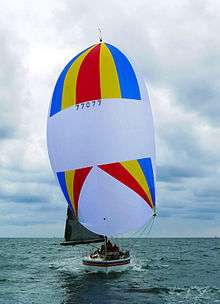
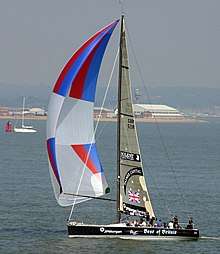
The spinnaker is often called a kite, or a chute (as in cruising chute) because it somewhat resembles a parachute in both construction and appearance. This should not be confused with the spinnaker chute, which is a hull fitting sometimes used for launching and recovering the spinnaker. A purported etymology has the first boat to carry this sail being a Cowes yacht named Sphinx, from which "Sphinx's Acre" and eventually "Spinnaker".[1][2]
Operation
A spinnaker is used for sailing with the direction of the wind. Symmetrical spinnakers have large amounts of camber, making them nearly hemispherical. Both lift and drag propel the boat forward when moving with the wind. Reaching spinnakers have less camber as they operate within an airflow that generates lift.
A well designed spinnaker will have taut leading edges when filled; leading edges that curl in will both reduce the lift and risk of collapse of the spinnaker. Such a sail will also have a smooth curve when filled, with no bubbles or depressions caused by inconsistent stretching of the fabric. Any deviations from a smooth curve will cause the airflow over the leeward side of the sail to separate causing a reduction in lift and reduced performance.
Types of spinnakers
There are two main categories of spinnakers, symmetric and asymmetric depending on whether a plane of symmetry exists for that particular sail. Asymmetric spinnakers operate more like a jib, generating lift from the side, rather than the top like a symmetric spinnaker. This makes asymmetrics a better choice on reaching courses than symmetric spinnakers, which excel when running. While a fully equipped racing boat might have a number of spinnakers, both symmetric and asymmetric, to cover all courses and wind conditions, cruising boats almost always use an asymmetric, due to the broader application and easier handling afforded by the asymmetric.
Symmetric spinnakers
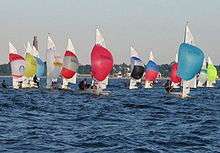
The symmetric one is the most classic type, running symmetrical alongside the boat controlled by lines known as a sheet and a guy running from the lower two corners of the sail. The windward line, or guy, is attached to the corner called the tack of the sail, and is stabilized by a spinnaker pole. The leeward (downwind) line is called the sheet. It attaches to the clew of the spinnaker and is used to control the shape of the sail. The spinnaker pole must be moved in each gybe, and is quite difficult for beginners to use. However, it can be sailed in all downwind wind directions.
Symmetric spinnakers when sailing across the wind (reaching) develop most of their lift on the forward quarter, where the airflow remains attached. When correctly set for reaching, the leading edges of a symmetric spinnaker should be nearly parallel to the wind, so the flow of air over the leading edge remains attached. When reaching, the sail camber allows only some attached flow over the leeward side of the spinnaker. On running the spinnaker is angled for maximum drag, with the spinnaker pole at right angles to the apparent wind. The symmetric spinnaker also requires care when packing, since the three corners must be available on the top of the packing.
Asymmetric spinnakers
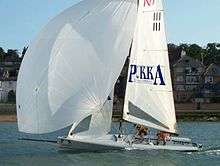
Asymmetrical spinnaker resembling large jibs and flown from spinnaker poles are not a new idea and date back to at least the 19th century. However in the 1980s a new concept appeared, starting with the Sydney Harbour 18ft Skiff fleet.
Since the 1960s many faster sailing craft, starting with catamaran classes, had discovered that it is faster to sail downwind on a series of broad reaches with efficient airflow across the sail rather than directly downwind with the sails stalled. This technique had developed to the extent that in bar conversation at the end of one season Andrew Buckland observed that the 18s had sailed all season without pulling the spinnaker pole back from the forestay and that all the systems could be simplified by eliminating the pole and setting the spinnaker from a fixed (but often retractable) bowsprit. The concept quickly evolved to a sail with a loose luff much more like a conventional spinnaker than the old jib style asymmetric sails. Julian Bethwaite was the first to rig and sail a boat with one the next season, followed shortly by Andrew Buckland. The first modern offshore sailboats to incorporate a retractable bow sprit and an asymmetric spinnaker was the J/Boats J/105.[3]
The concept has spread rapidly through the sailing world. The tack of the sail may be attached at the bow like a genoa but is frequently mounted on a bowsprit, often a retracting one. If the spinnaker is mounted to a special bowsprit, it is often possible to fly the spinnaker and the jib at the same time; if not, then the spinnaker will be shadowed by the jib, and the jib should be furled when the spinnaker is in use.
The asymmetric has two sheets, very much like a jib, but is not attached to the forestay along the length of the luff, but only at the corners. Unlike a symmetric spinnaker, the asymmetric does not require a spinnaker pole, since it is fixed to the bow or bowsprit.[4] The asymmetric is very easy to gybe since it only requires releasing one sheet and pulling in the other one, passing the sail in front of the forestay. Asymmetrics are less suited to sailing directly downwind than spinnakers, and so instead the boat will often sail a zig-zag course downwind, gybing at the corners. An asymmetric spinnaker is particularly effective on fast planing dinghies as their speed generates an apparent wind on the bow allowing them to sail more directly downwind. It is also particularly useful in cruising yachts in the form of a cruising spinnaker or cruising chute, where the ease of handling is important.
Cruising chute
A cruising chute is a form of asymmetric spinnaker used by cruising yachts and designed for easy use when short handed. Two sheets are used, with the tack line eased by a foot or so before gybing. Alternatively only one sheet is used, with the sail snuffed before a gybe.[5]
Nomenclature
Many boats will have more than one spinnaker, especially when racing. To differentiate between them sailors and sailmakers have adopted a common but not compulsory nomenclature. Numbers are generally used to indicate size, where lower numbers indicate larger sails and higher numbers indicate a smaller sails, this is similar to the numbering used for other headsails (e.g. jib or genoa). In addition to the number an A for asymmetric or S for symmetric will usually be added as a prefix. So a boat might carry an S2 and an A1.
The following codes are used for both symmetric[6] and asymmetric[7] sails.
- Code 1 is a light air reaching sail, where the apparent wind angles at low speeds has a significant effect to create angles of less than 90 degrees.
- Code 2 is a medium air running sail, used for apparent wind angles over 90 degrees.
- Code 3 is a medium air reaching sail, used for apparent wind angles near 90 degrees.
- Code 4 is a heavy air running sail, used in the heaviest winds normally expected.
- Code 5 is a heavy air reaching sail, used in the heaviest winds normally expected.
- Code 6 is a storm sail, for running in storm conditions.
The Code Zero
The code 0 asymmetric is a tight reaching sail, that was developed in the Whitbread Round the World Race by Robert "Hooky" Hook for Paul Cayard's successful EF Language. In that race it replaced the jibs for light upwind work in addition to many off wind angles. The luff is as straight as possible, and the sail is flatter than other asymmetric spinnaker. Due to the flatness of the code 0, it is usually made with a high modulus luff line for supporting strength, and of a heavier, less stretchy fabric than normal for a spinnaker. Due to the tight luff and flat cut, the code 0 can be fitted for roller furling.
Some boats even carry two code zeros, usually referred to as the masthead zero (MH0) and the fractional zero (FR0).[8] The luff of the masthead zero will run from the tack to the top of the mast. The luff of the fractional zero will run from the tack to the top of the forestay on a boat that is a fractional rig. This means that the FRO is usually smaller than the MHO. Sailors will often pronounce MHO as 'mo', like the slang for a mohawk and the FRO as 'fro' like the slang for an afro haircut.
Spinnakers for cruising boats are starting to be patterned after the roller furling code 0 racing spinnakers, as they provide the easiest handling. North Sails, for example, offers three gennaker sails, based on the racing code 0 asymmetrics, with different sizes and cambers for varying angles and wind speeds. Other manufacturers offer similar cruising code 0 designs under different names, such as the screecher and reacher for upwind and downwind use respectively.
Flying the spinnaker
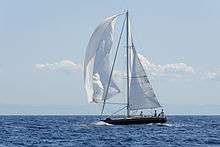
Since they will only be used on certain points of sail, raising and lowering the spinnaker is a task that is often performed while under sail. Due to the size of spinnakers (the spinnaker is often double or more the size of the mainsail) this can be a difficult operation, since the sail will immediately catch the wind.
Rigging the symmetric spinnaker
Typically the symmetric spinnaker is packed in its own bag, called a turtle, with the three corners on top for ready access. The clews (lower corners) are controlled by lines called sheets. The sheets are run in front (outside) of the forestay and lead to the back of the boat. The head (top corner) is attached to the spinnaker halyard, which is used to raise the sail up the mast.
Symmetric spinnakers have the windward clew secured to a spinnaker pole. The pole is attached to the mast and holds the windward edge of the sail in position. Lines that control the spinnaker pole are called guys or braces. The spinnaker pole may be allowed to raise and lower with the force of the wind, or it may have lines attached to it to raise (the topping lift) and lower (the foreguy or downhaul) the angle of the pole. If these lines are used, they are generally set up before setting sail, and left in place even when the spinnaker is stowed.
Since spinnakers are downwind sails, they are never tacked, they are only jibed. When jibing a symmetric, the pole is removed from one corner and attached to the opposite corner. This corner now becomes the windward corner. There are two ways this is done. Generally on smaller boats, an end-for-end jibe is accomplished by disconnecting the pole at the mast-end and connecting the mast end to the opposite side of the sail. The old sail end is disconnected and then attached to the mast. This prevents the pole from getting loose during the procedure and allows the use of only two control lines that alternate as sheet and guy (more on this below). End-for-end jibing requires a pole with identical fittings at either end. Larger boats do a dip-pole gybe (jibe) in which the pole remains attached to the mast and the outer end is lowered until it can clear the head-stay and is then raised back up on the other side of the boat to the proper height with the topping lift. The guys are adjusted as before to set the sail angle on the new course. Dip-pole jibing can use a pole with one mast end and one sail end.
Smaller boats tend to use only one line on each clew (a combination guy and sheet). The windward line that runs through the jaw of the spinnaker pole is referred to as the guy (as opposed to foreguy) and the one on the free-flying corner is referred to as the sheet. During a jibe, these roles and thus the names are reversed. Larger boats may choose to use both a sheet & guy on each corner, with the guy being a heavier line. Having 2 sets of lines will makes the jibe easier as the kite is flown by the two sheets while the crew at the bow and at the mast are removing one guy from the pole and attaching it to the other with no tension on them.
Retrieving the spinnaker is a multi-step process, and the take-down depends on wind position. First, the windward corner is detached from the spinnaker pole and the guy is released. This step is referred to as blowing the guy. This allows the spinnaker to collapse into the shadow of the mainsail, where the foot is gathered by a crew member. The halyard is then lowered, and a crew member gathers the sail and stuffs it carefully into the turtle, corners out, and ready for the next deployment. There are, however many other ways to retrieve the spinnaker depending on the conditions and intent. It may or may not go into a turtle. It may be pulled back into the cockpit & then down below to be repacked for the next hoist or be pulled in a foredeck hatch & left free for the next hoist.
Rigging the asymmetric spinnaker
Like the symmetric, the Asymmetrical spinnaker is often stored in a turtle, with the corners on top for easy access. While a symmetric spinnaker is flown with a "guy" and a "sheet", an asymmetric spinnaker is flown with a tackline and a "sheet." The tack attaches to the bow or (often retractable) bowsprit, and the two sheets attach to the clew. The head of the sail is attached to the spinnaker halyard, which is used to raise the sail. The sheets are passed to either side of the forestay, attached to the clew; they may be passed forward of the luff of the asymmetric, or aft of the luff of the asymmetric, between the tack line and the forestay. The sheet on the downwind (lee) side of the hull is used to trim the sail, and the opposite sheet is left slack. Often a tack line is used at leading edge to provide adjustable tension on the luff of the spinnaker. To keep the tack near the centerline of the boat, it may be attached to the forestay with a sliding collar (often riding over the furled jib on parrel beads, tacker or similar device) adjustable with a down haul, or tack line. This allows the tack to slide up and down the forestay to adjust the luff tension.[9] On racing boats, the tack of the asymmetric is often rigged to a retractable bowsprit, which increases the foretriangle area and prevents interference with the jib. As this trend becomes more popular in racing boats, it may result in similar adaptations to cruising boats as well.[10]
Jibing with the asymmetric is much less complex than the symmetric, due to the lack of the spinnaker pole. Much like a jib, all that is required is to change sheets. However, since the asymmetric still flies in front of the forestay, the operation is reversed. The loaded sheet is slackened, and the opposite (lazy) sheet is pulled in, which allows the sail to pass around in front of the forestay, and then be sheeted in on the new lee side of the boat.
Retrieving the asymmetric is similar to the process for the symmetric. The sheets are released, allowing the sail to collapse to the front of the boat. The foot of the sail is then gathered, and the halyard released and the head of the sail lowered, where it is packed into the turtle.
Dousing socks
The dousing sock, "spinnaker sleeve", snuffer, or just sock, is a device used to make deploying and retrieving the spinnaker a much easier task. The sock is a long fabric tube with a ring in one end to hold it open. Since the spinnaker is stored in the sock, the first step is to set up the sock. Two lines are attached to the sock; one is attached to a bridle on the ring, for pulling the sock down, and one is up the inside, from the ring, through the top, and back down, for raising the sock; these lines may be two ends of the same line, to form a loop. The head of the spinnaker is attached the top of the sock and the ring runs down to the tack. The resulting bundle is stuffed into the spinnaker bag. The top of the sock will have provisions for attaching to the spinnaker halyard.
The spinnaker is raised as normal, but with the sock in place the spinnaker is unable to catch the wind. Once the spinnaker is raised and the guys are ready to set, the sock is raised, releasing the spinnaker. The sock remains bundled up at the head of the sail while the spinnaker is deployed. To retrieve the spinnaker, the sheet or the tack is released and the sock is pulled down, gathering the sail. The halyard is then dropped and the sail may be packed away.
Spinnaker chute
A spinnaker chute is usually a tube or aperture in the deck close to the forestay, for the launching and recovery of the spinnaker. They are most commonly found on modern dinghy designs, and updated older classes. To allow recovery of the spinnaker into the chute, one or more recovery patches are fitted to the spinnaker, to which the tail of the spinnaker halyard is attached or passed through. The spinnaker and its halyard thus form a continuous loop, passing through the chute.
If the spinnaker chute penetrates the hull and is required to be watertight, it takes the form of a hard tube sealed to the hull at both ends. If a watertight arrangement is not required, a cloth tube may be used to contain the lowered spinnaker. Various types of spinnakers, can be used with it. Asymmetrical spinnakers are often paired with chutes.
Etymology
Some dictionaries suggest that the origin of the word could be traced to the first boat to commonly fly a spinnaker, a yacht called Sphinx, mispronounced as Spinx.[11] Sphinx first set her spinnaker in the Solent in 1865, and the first recorded use of the word was in 1866 in the August edition of Yachting Calendar and Review (p. 84).[12] In addition, the term may have been influenced by the spanker, originally a gaff rigged fore-and-aft sail.[13]
Another suggestion is that the idea for the sail was conceived in 1865 by William Gordon, owner of the racing yacht Niobe. He wanted to name the sail after his yacht but a crewman's comment, 'Now there's a sail to make her spin' became 'spin maker' which developed into the commonly accepted term spinnaker. Gordon was widely known in the yachting world of the time as 'Spinnaker Gordon.'[14]
It has been pointed out, however, that the skippers of Thames sailing barges also used the term spinnaker for their jib staysails. Unlike the other, tanned sails of these boats, the spinnakers were usually of white color. It has thus been suggested that the term could be "connected with the obsolete word spoon, meaning to run before the wind (cf. spindrift)." Early usage of the verb to spoon can be traced back to the 16th century; the change from spoon to spin in the term spindrift is attributed to a local Scottish pronunciation.[15] According to Merriam Webster's dictionary, however, spindrift derives from a local Scottish pronunciation of speen (not spoon), meaning "to drive before a strong wind."[16]
Furthermore, references to a mid-nineteenth-century origin are problematic. In the logbook of the USS Constitution, opening "Remarks on Board Monday July 13th 1812" is the comment "From 12 to 4 AM moderate breezes and thick cloudy weather with rain at 1 AM hauled up the mainsail and set the spinnaker at ½ past 3 AM set the mainsail JTS [John T. Shubrick, Fifth Lieutenant]."[17]
According to Merriam-Webster's etymology, the origin of the word spinnaker is simply unknown.[18]
References
- Mitchell, Leeds, Jr. (March 1976). "Sleuthing Seagoing Semantics". Boating: 123. ISSN 0006-5374.
- "Spinnaker". Oxford English Dictionary (3rd ed.). Oxford University Press. September 2005. (Subscription or UK public library membership required.)
- Robert H. Perry (November 2006). "J/105". Sailing Magazine. Archived from the original on September 27, 2007. Retrieved 2007-02-23.
- http://www.classicmarine.co.uk/Articles/rigintro.htm
- http://www.kempsails.com/index2.php?option=com_docman&task=doc_view&gid=11&Itemid=12
- "Symmetric Racing Spinnakers - Doyle Sailmakers". www.doylesails.com.
- "Asymmetric Racing Spinnakers - Doyle Sailmakers". www.doylesails.com.
- Race, Volvo Ocean. "The sails".
- "Cruising with an Asymmetrical Spinnaker". Retrieved 2007-09-04.
- "J Boats". Retrieved 2007-09-10.
- Spinnaker entry in the Compact Oxford English Dictionary; Spinnaker entry in The Concise Oxford Dictionary of English Etymology (1996). Oxford University Press. According to encyclopedia.com. Both retrieved on 20 July 2008.
- Mayne, Richard (2000). The Language of Sailing (Print). Chicago, Ill: Fitzroy Dearborn;Taylor & Francis. p. 282. ISBN 1-57958-278-8.
- Spinnaker entry in the Compact Oxford English Dictionary. Retrieved on 20 July 2008.
- Drower, George M.F.; Ainslee, Ben, foreword (1 September 2011). Boats, Boffins and Bowlines: The Stories of Sailing Inventors and Innovations. Transportation (Print). Stroud, Gloucestershire: The History Press. pp. 256 at 97. ISBN 075246065X.
- Chatterton, Edward Keble (1912). Fore and aft, the story of the fore & aft rig from the earliest times to the present day. Philadelphia, London: J. B. Lippincott company, Seeley, Service & Co. Ltd. pp. vii, 232–233. at Internet Archive As cited in: Mayne, Richard (2000). The Language of Sailing (Print). Chicago, Ill: Fitzroy Dearborn;Taylor & Francis. p. 282. ISBN 1-57958-278-8.
- Spindrift entry on Merriam Webster. Retrieved 20 July 2008.
- Logbook of the USS Constitution in the National Archives of the United States.
- Spinnaker entry on Merriam Webster. Retrieved 20 July 2008.
External links
| Wikisource has the text of the 1905 New International Encyclopedia article Spinnaker. |
| Look up spinnaker in Wiktionary, the free dictionary. |